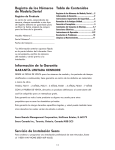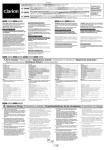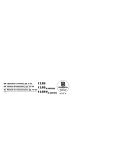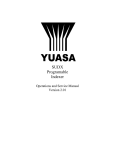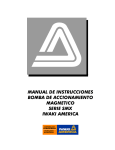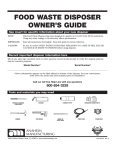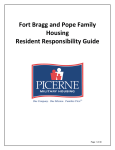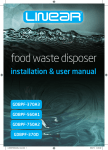Download Kenmore 1/2 Horsepower Deluxe Disposer - Dark Gray Owner's Manual
Transcript
Use & Care Guide Guía de Cuidado y Uso Models/Modelos: 587.70235, 70211, 70321, 70351, 70361 Kenmore ® Food Waste Disposer Triturador de Alimentos Sears Brands Management Corporation Hoffman Estates, IL 60179 U.S.A. www.kenmore.com www.sears.com Sears Canada Inc. Toronto, Ontario, Canada M5B 2C3 www.sears.ca ® P/N 560C525P07 RevA Record Model/Serial Numbers Product Record Bill of sale, sales slip, cancelled check or other purchase record should be kept to verify the original purchase date for warranty purposes. Model Number:* Serial Number:* Purchase Date: Table of Contents Record Model/Serial Numbers ..........2 Warranty Information ......................2 Important Safety Instructions ............3 Removal of Old Disposer...................4 Dishwasher Connection.....................5 Installation of Mounting Assembly ....5-7 Electrical Connections .......................8 Operating Instructions .....................8-9 Troubleshooting ..............................10 Cleaning and Maintenance................11 *Above information appears on the label affixed to bottom of the disposer. For your convenience, write down the model and serial numbers prior to installation. Warranty Information KENMORE LIMITED WARRANTY FROM THE DATE OF SALE for the model numbers and time periods listed below, this product is warranted against defects in material or workmanship. 70235, 70211 - 2 YEARS, 70321 - 3 YEARS, 70351 - 5 YEARS, 70361 - 7 YEARS WITH PROOF OF SALE, return a defective product to the retailer from which it was purchased for free replacement. This warranty is void if this product is ever used for other than private household purposes. This warranty gives you specific legal rights, and you may also have other rights which vary from state to state. Sears Brands Management Corporation, Hoffman Estates, IL 60179 Sears Canada Inc., Toronto, Ontario, Canada M5B 2C3 Sears Installation Service To order and schedule professional installation of this disposer, call 1-800-4-MYHOME (800-469-4663) 2 IMPORTANT SAFETY INSTRUCTIONS Read all instructions before using this appliance See insert for specific information about you new disposer NOTE: This Food Waste Disposer has CAUTION: Be sure to review SAFETY been designed to operate on 110120 Volt, 60Hz exclusively. Using any other voltage or Hz adversely affects performance. INSTRUCTIONS FIRST PERTAINING TO A RISK OF FIRE, ELECTRICAL SHOCK OR INJURY TO PERSONS before using disposer. IMPORTANT: Read all instructions thoroughly. Keep this guide for future reference. INSTRUCTIONS PERTAINING TO A RISK OF FIRE, ELECTRIC SHOCK OR INJURY TO PERSONS. SAVE THESE INSTRUCTIONS. NOTE: If you are not familiar with electrical power and procedures, call a qualified electrician. WARNING: Improper connection of the equipment-grounding conductor can result in a risk of electric shock. Check with a qualified electrician or serviceman if you are in doubt as to whether the appliance is properly grounded. Do not modify the plug provided with the appliance if it will not fit the outlet, have a proper outlet installed by a qualified electrician. WARNING: When using electrical appliance, basic precautions should always be followed, including the following: 1. Read all instructions before using the appliance. 2. To reduce the risk of injury, close supervision is necessary when an a appliance is used near children. 3. Do not put fingers or hands into a waste disposer. 4. Turn the power switch to the off position before attempting to clear a jam or remove an object from the disposer. 5. When attempting to loosen a jam in a waste disposer, use a long wooden object such as a wooden spoon or the wooden handle of a broom or mop. 6. When attempting to remove objects from a waste disposer use long-handled tongs or pliers. If the disposer is magnetically actuated, non-magnetic tools should be used. 7. To reduce the risk of injury by materials that may be expelled by a waste disposer, do not put the following into a disposer: clam or oyster shells, caustic drain cleaners or similar products; glass, china or plastic; large whole bones; metal, such as bottle caps, tins cans, aluminum foil or utensils; hot grease or other hot liquids; whole cornhusks. 8. When not operating the disposer, leave the stopper in place to reduce the risks of objects falling onto the disposer. 9. For proper grounding instructions see the ELECTRICAL CONNECTION portion of this manual. Save these instructions for future reference 3 Removal Of Old Disposer TYPICAL INSTRUCTIONS, YOUR MODEL MAY VARY. A BA B E DC ED EF E G IMPORTANT: Unless you have a new home, this is a good time to clean out the trap and drain lines by running a drain auger or plumber’s snake before installing your new disposer. A B B C D C . C D E 1.Unplug the disposer or turn off the electrical power at the circuit breaker or fuse box. 2.Use a pipe wrench to disconnect the drain line where it attaches to the disposer discharge elbow (see B). 3.If a dishwasher is installed, make sure the dishwasher is not running (We recommend unplugging the dishwasher or turning off the electrical power at the circuit breaker or fuse box) then remove the dishwasher drain hose from the disposer (see C). 4.Remove disposer from sink flange by turning lower mount ring to the left (see D). If you are unable to turn the mount ring, tap on one of the extensions from the ring with a hammer. Some mounting systems have tubular extensions. Inserting a screwdriver into one tube will provide additional leverage for turning the mount ring (See D). Some disposers may require the removal of a clamp. CAUTION: Be sure to support the disposer while performing this step or it may fall when the lower mounting ring is disconnected from the mounting assembly. If your disposer is hard wired (metal shielded cable not utilizing a wall plug), complete steps E and F. If you utilize a plug-in cord, go on to step G. 5.When the disposer is removed, turn it upside down and remove the electrical cover plate (see E). 6.Using a screwdriver, loosen the green ground screw and remove the green ground wire. Remove the wire nuts from the black and white power wires and separate the disposer wires from power cable wires. Loosen the screws on cable clamp and separate cable from disposer (see F). 7. If the existing sink flange is to be re-used, go to page 6. 8.If replacing a 3-bolt style mount system, loosen the 3 mount screws and push the lower mount ring up. Under it is the snap ring. Use a screwdriver to remove the snap ring (see G). Remove the mount ring, backup flange and gasket from the sink flange. 9.EZ mount systems may require the unscrewing of a large ring holding the sink flange in place. Once unscrewed you can remove the flange. 10.Remove the old sink flange from the sink. Clean the sink thoroughly. 4 Dishwasher Connection If you are utilizing a dishwasher, complete the following procedure. If dishwasher is not to be connected go to section Installation of Mounting Assembly. A. Using a blunt instrument (steel punch or wooden dowl), knock out entire plug (see A). Do not use a screwdriver or sharp instrument. When knockout plug falls into disposer, you may remove it or simply grind it up when the disposer is used. This will not damage the disposer in any way, but may take some time to grind over the course of several uses. Go to section Installation of Mounting Assembly. B. Connect dishwasher hose using hose clamp. If hose size is different, you will need a Dishwasher Connector Kit (see B). Make sure all plumbing connections are tight and in accordance with all plumbing codes and ordinances. Run water and check for leaks. B *AIR GAP DISHWASHER HOSE A KNOCK OUT PLUG DISPOSER RUBBER HOSE *Air gap may not be required for all installations. Check local plumbing codes. Mounting Assembly 1 Stopper SINK SINK 2 3 4 Sink Flange PLUMBER’S PUTTY A SINK FLANGE** STOPPER* RIDGE SINK FLANGE** Fiber Gasket PLUMBER’S PUTTY Backup Flange FIBER GASKET RIDGE BACKUP FLANGE FIBER GASKET SCREWS BACKUP FLANGE MOUNTING RING 5 6 Mounting Ring MOUNTING RING SNAP RING SNAP RING LOWER MOUNTING RING Screws HUSH CUSHION ® 7 Snap Ring 8 Hush Cushion RUBBER GASKET RESET BUTTON 9 Lower Mounting Ring * Batch Feed Stopper looks different than the stopper illustrated. ** Mount Assembly ** Mount Assembly NOTE: Hush Cushion is included between mounting ring and lower mounting ring. 5 Installation of Mounting Assembly READ COMPLETELY BEFORE STARTING NOTE: Pay close attention to the order of the mounting assembly parts, as they have been correctly assembled by the factory. A 2 7 D E 3 2 2 4 B 5 C 6 1. Disassemble the mounting assembly from the disposer by turning the lower mount ring until it disengages from the ramps on the mounting ring and the sink flange assembly can be removed. Loosen the 3 mount screws until the mounting ring can be moved up to the backup flange. Use a flat blade screwdriver under one end of the snap ring to remove it from the sink flange. Remove the mounting ring, backup flange and fiber gasket from the sink flange. Note the sequence of these parts as they are stacked in the correct re-assembly sequence. Keep these parts together and set aside. 2. Clean the area around the sink drain where the disposer is to be mounted. Evenly apply ½” thick rope of plumber’s putty around flange (see A). Position the sink flange (2) in the center of the sink drain opening. Push the sink flange down firmly to make a good seal (see B). Note: Excess putty will be squeezed out during the installation and should not be cleaned up until the end DO NOT move or rotate the sink flange once seated or the seal may be broken. Note: Some sink manufacturers may recommend “Non- Staining” plumber’s putty; check your sink care instructions. 3. Using a towel in the sink to prevent scratching, place a weight (such as the disposer) on the sink flange to hold it in place until the sink flange assembly is secured from the underside of the sink. 4. Reassemble the fiber gasket, (3) backup flange (4) and mounting ring, (6), making sure the fiber gasket is on top of the backup flange, and that the backup flange is on top of the mounting ring (see C). They must be in this order! From underneath the sink flange, place the gasket/flange/ring assembly, gasket on top, onto the sink flange (see D). 5. Holding all 3 parts up against the sink, pull the snap ring (7) open and press firmly into the groove on the sink flange until it snaps into place (see D). Once in place, it will hold the mounting ring up. 6. Insert 3 mounting screws (5) into mounting ring and tighten screws evenly and firmly against the backup flange (see E). Use shorter screws if the sink is more than 3/8” thick. DO NOT OVERTIGHTEN! Trim off excess putty in the sink. NOTE: Shorter screws should be available at your local hardware store. NOTE: Read Operating Instructions at the end of installation. 6 Attaching Discharge Elbow/ Connecting Disposer To Mount Assembly 1. Install the provided discharge elbow/gasket assembly (these are pre-assembled at the factory) and flange as shown in “A”. Install and tighten two screws evenly with a screw driver. DO NOT RE-USE THE EXISTING DISCHARGE ELBOW AND GASKET AS THE GASKET MAY NOT SEAL PROPERLY. USE THE NEW ELBOW, GASKET, FLANGE AND SCREWS PROVIDED. DO NOT OVERTIGHTEN! IMPORTANT: Do not remove the gasket and place it on the disposer between the elbow and disposer. It must stay on the elbow to make a proper seal. 2. Before connecting the disposer to the mounting assembly under the sink, check that the lower mounting ring is in place on the top of the disposer, and that the hush cushion is engaged securely around the top lip of the disposer (see B). 3. Align the discharge elbow with the drain connection and hang the disposer by aligning the 3 mounting tabs on the lower mounting ring with the slide-up ramp on the mounting ring (see C). 4. Turn the lower mounting ring until all 3 mounting tabs lock over the ribs at the top of the ramp (see D). If you are unable to turn the mount ring by hand, insert a screw driver through one of the tubes on the lower mounting ring to provide extra leverage to turn it. 5. Use a pipe wrench to reconnect the discharge elbow to the drain line (see E). (the reversal of page 3, step B) Use a pipe wrench to secure the drain line where it attaches to disposer discharge tube. DO NOT OVERTIGHTEN (see E). 6. If you are connecting to a dishwasher, go to “Dishwasher Connection” on page 5. If not, remove any tools, packaging or materials used for installation from the sink. Make sure all plumbing connections are tight and in accordance with all plumbing codes and ordinances (If in doubt, contact a qualified plumber). Run water and check for leaks (see Leaks on page 10). Then go to page 8 for the electrical connection. NOTE: Read Operating Instructions at the end of installation. RUBBER GASKET B A A C D LOWER MOUNT RING TUBE D E A HUSH LOWER CUSHION MOUNTING RING RAMP C 7 D Grounding Instructions For Waste Disposers equipped with a grounded plug-in power cord For Waste Disposers not equipped with a grounded plug-in power cord This appliance must be grounded. In the event of a malfunction or breakdown, grounding provides a path of least resistance for electric current to reduce the risk of electric shock. This appliance is equipped with a cord having an equipment-grounding conductor and a grounding plug. The plug must be plugged into an appropriate outlet that is properly installed and grounded in accordance with all local codes and ordinances. This appliance must be grounded. In the event of a malfunction or breakdown, grounding provides a path of least resistance for electric current to reduce the risk of electric shock. The power cord (to be installed) must have an equipmentgrounding conductor and a grounding plug. The plug must be plugged into an appropriate outlet that is properly installed and grounded in accordance with all local codes and ordinances. Disconnect electric power to disposer circuit before installation. Turn the circuit breaker to the OFF position or remove the fuse. Electrical Connections Connecting Disposer to a Plug-In Cord 1. Connect disposer to 110-120 Volt, 60Hz AC current only. 2. If plug-in cord is used, use a three prong plug (see A). Ground wire should be attached to the ground screw in the bottom of the end bell (see B). Wiring Disposer Directly to House Current This appliance must be connected to a grounded, metal permanent wiring system or an equipment grounding conductor must be run with the circuit conductors and connected to the equipment-grounding terminator or lead on the appliance. A. 3. Use a cable clamp strain relief connector where the power cord enters the disposer (see C). Trace lead connected to this blade and attach that lead to white wire on disposer . A RIBBED SIDE NOTE: When viewing face of electical plug with grounding pin at top, the larger left blade is connected to the identified wire . B C RED RESET BUTTON GROUND SCREW TO HOUSE CURRENT OR POWER CORD STRAIN RELIEF WIRE NUTS REMOVE COVER PLATE NUT If you use BX cable: 1. Install cable connector in hole. 2. Connect white wire to white lead of disposer. 3. Connect black. 4. Connect bare ground. If BX cable is not used, provide a separate ground wire to nearest cold water metal pipe or other suitable ground, using the screw in the bottom of the end bell for the ground wire (see C). B. If your power supply does not include a ground wire, you must provide one unless metal cable is used. Attach a copper wire securely to disposer ground screw and attach other end of wire to a metal cold water pipe. Use only UL approved ground clamp. If plastic pipe is used in your home, a qualified electrician should install a proper ground. 8 Operating Instructions The Anti-Jam Swivel Impellers make a clicking sound as they swing into place. This indicates normal operation. 1. Remove sink stopper. Turn on a medium flow of cold water. 2. Turn the wall switch to the ON position; your motor is turning at full speed and ready to use. 3. Scrape in food waste, like table scraps, peelings, rinds, seeds, pits, small bones and coffee grounds. To speed up food waste disposal, cut or break up large bones, rinds and cobs. Large bones and fibrous husks require considerable grinding time and are more easily thrown away with other trash. Do not be alarmed that the disposer slows down while grinding. The disposer is actually increasing torque (grinding power) and is operating under normal conditions. 4. Before turning disposer off, let water and disposer run for approximately 15 seconds after shredding stops. This assures that all waste is thoroughly flushed through trap and drain. 5. It is not recommended to use hot water while running disposer. Cold will keep waste and fats solid so the disposer can flush away particles. Batch Feed Operating Instructions The Anti-Jam Swivel Impellers make a clicking sound as they swing into place. This indicates normal operation. For batch food operation, the sink stopper can be used to bypass the wall switch to start the disposer. 1. Remove sink stopper. Turn on a medium flow of cold water. 2. Scrape in food waste, like table scraps, peelings, rinds, seeds, pits, small bones and coffee grounds (see A). 3. Insert stopper to start disposer (see B). One of the two smalls slots in stopper base must line up with switch plunger inside the neck of the disposer. Push down firmly to turn the disposer on. Lift stopper to shut the disposer off. 4. Run disposer for 15 seconds after shredding stops. This assures that all waste is thoroughly flushed through the drain. 5. To fill sink, insert stopper and align the largest slot with the switch plunger (see C). Push down to seal sink without starting the disposer. When the medium sized slot (see B) in stopper base is lined up with the switch plunger, water can drain but tableware, etc., cannot be accidently dropped into disposer. 9 Troubleshooting Tips for Successful Operation 1. Be sure disposer is empty before using your dishwasher so it may drain properly. 2. You may want to leave the stopper in the drain when not in use to prevent utensils and foreign objects from falling into the disposer. 3. Your disposer is ruggedly built to give you many years of trouble free service. It will handle all normal food wastes, but it will NOT grind or dispose of such items as plastic, tin cans, bottle caps, glass china, leather, cloth, rubber, string, clam and oyster shells, aluminum foil or feathers. Before seeking repair or replacement, we recommend that you review the following: Loud Noises: (Other than those during grinding of small bones and fruit pits): These are usually caused by accidental entry of a spoon, bottle cap or other foreign object. To correct this, turn off electrical switch and water. After disposer has stopped, remove object with long handled tongs. Unit Does Not Start: Unplug power cord or turn either the wall switch or breaker box switch to “OFF” position, depending on your model and wiring configuration. Remove stopper. Check to see if grinding mechanism turntable will rotate freely using a wooden broom handle. If turntable rotates freely, check reset button to see if it has been tripped. Re-set button is red and located opposite discharge elbow, near the bottom (see A). Push button in until it clicks and remains depressed. If re-set button has been tripped, check for a short or broken wire connecting to disposer. Check electrical power switch, fuse box or circuit breaker. If wiring and electrical components are intact, the unit may have internal problems that require service or replacement. If Turntable Does Not Rotate Freely: Turn off disposer, then check for any foreign object lodged between the grinding mechanism turntable and grind ring. Dislodge object by rotating table with a wooden broom handle and remove object (see 8B). If no foreign object is present, there may be internal problems. Leaks: If the unit leaks at the top, it may be due to: 1. Improper seating of sink flange (gasket centering, putty or tightening). 2. Support ring not tightened properly. 3. Defective or improperly installed hush cushion. If unit leaks at the waste elbow, leak may be due to improper tightening of elbow flange screws. 10 Cleaning and Maintenance DO NOT ATTEMPT TO LUBRICATE YOUR DISPOSER The motor is permanently lubricated. The Mineral deposits in water can form on disposer is self cleaning and scours its the grinding mechanism turntable, giving internal parts with each use. the appearance of rust. DO NOT BE ALARMED. The turntable is made of stainless steel and will not corrode. NEVER put lye or chemical drain cleaners into the disposer as they cause serious corrosion of metal parts. If used, resulting damage can be easily detected and all warranties are void. Notes 11 12 Registro de los Números Tabla de Contenidos de Modelo/Serial Registro de los Números de Modelo/Serial.....2 Registro de Producto La carta de venta, comprobante de compra, cheque cancelado u otro tipo de registro deberá ser guardado para verificar la fecha original de compra para los fines de la garantía. Modelo Número:* Serial Número:* Información de Garantía...............................2 Instrucciones Importantes de Seguridad.........3 Remoción de la Antigua Unidad.....................4 Conexión al Lavaplatos.................................5 Instalación del Conjunto de Montaje............5-7 Conexiones Eléctricas....................................8 Instrucciones de Operación.........................8-9 Resolución de Problemas............................10 Limpieza y Mantenimiento..........................11 Fecha de Compra: *La Información anterior aparece fijada en la parte inferior del triturador. Para su conveniencia, escriba los números del modelo y serial previo a la instalación. Información de la Garantía GARANTÍA LIMITADA KENMORE DESDE LA FECHA DE VENTA para los números de modelo y los periodos de tiempo clasificados a continuación, tiene garantía en contra de los defectos en materiales o mano de obra. 70235, 70211 - 2 AÑOS, 70321 - 3 AÑOS, 70351 - 5 AÑOS, 70361 - 7 AÑOS CON LA PRUEBA DE VENTA, devuelva un producto defectuoso al comerciante del cual fue adquirido para un reemplazo gratis. Esta garantía es nula si este producto es alguna vez usado para otros propósitos que no sean los domésticos privados. Esta garantía le otorga derechos específicos legales, y usted puede también tener otros derechos los cuales varían de estado a estado. Sears Brands Management Corporation, Hoffman Estates, IL 60179 Sears Canada Inc., Toronto, Ontario, Canada M5B 2C3 Servicio de Instalación Sears Para ordenar y programar una instalación profesional de este triturador, llame al 1-800-4-MY-HOME (800-469-4663) 13 INSTRUCCIONES IMPORTANTES DE SEGURIDAD Lea todas las instrucciones antes de usar este artefacto Vea el inserto para información específica sobre su nuevo triturador NOTA: Este Triturador de Alimentos PRECAUCIÓN: Asegúrese de ha sido diseñado para operar exclusivamente en 110- 120 Volt, 60Hz. Usar otro voltaje o Hz afecta negativamente su desempeño. revisar LAS INSTRUCCIONES DE SEGURIDAD PRIMERO PERTENECIENTES AL RIESGO DE INCENDIO, DESCARGA ELÉCTRICA O DAÑOS A LAS PERSONAS antes de usar el triturador. IMPORTANTE: Lea completamente todas las instrucciones. Guarde esta guía para futura referencia. INSTRUCCIONES PERTENECIENTES AL RIESGO DE INCENDIO, DESCARGA ELÉCTRICA O DAÑOS A LAS PERSONAS. GUARDE ESTAS INSTRUCCIONES. NOTA: Si no está familiarizado con la energía eléctrica y sus procedimientos, llame a un electricista calificado. ADVERTENCIA: La conexión inapropiada del conductor a tierra del equipo puede resultar en un riesgo de descarga eléctrica. Chequee con un electricista calificado o reparador si tiene dudas respecto a si el artefacto está bien puesto a tierra. No modifique el enchufe provisto con el artefacto si éste no se ajustase con el tomacorriente, tenga un tomacorriente instalado apropiadamente por un electricista calificado. ADVERTENCIA: Cuando use artefactos eléctricos, deberá seguir siempre las precauciones básicas, incluyendo las siguientes: 1. Lea todas las instrucciones antes de usar el artefacto. 2. Para reducir el riesgo de lesión, es necesaria la supervisión cercana cuando un artefacto es usado cerca de los niños. 3. No ponga los dedos o manos dentro del triturador. 4. Ponga el interruptor de energía en la posición de apagado en el intento de limpiar un atasco o remover un objeto del triturador. 5. Cuando intente aflojar un atasco en un triturador, use un objeto largo de madera tales como una cuchara de madera o el mango de madera de un trapeador. 6. Cuando intente remover objetos de un triturador, use tenazas o alicates de mango largo. Si el triturador está accionado magnéticamente, deberían ser usadas herramientas no magnéticas. 7. Para reducir el riesgo de lesiones por materiales que pudieran ser expelidos por un triturador, no ponga lo siguiente dentro del triturador: conchas de ostras o almejas; limpiadores de drenaje cáustico o productos similares; vidrio, porcelana o plástico; huesos enteros grandes; metal, tales como botellas, latas, papel aluminio o utensilios; grasa caliente u otros líquidos calientes; hojas de maíz enteras. 8. Cuando no opere el triturador, deje el tapón en su lugar para reducir los riesgos de que los objetos caigan dentro del triturador. 9. Para las instrucciones apropiadas sobre puesta a tierra, vea el fragmento de CONEXIONES ELÉCTRICAS de este manual. Guarde estas instrucciones para futura referencia 14 Remoción del Antiguo Triturador INSTRUCCIONES TÍPICAS, SU MODELO PUDIERA VARIAR. A BA B E DC ED EF E G IMPORTANTE: A menos que tenga un nuevo hogar, es buen momento para limpiar las líneas de sifón y de drenaje dejando correr un drenaje sinfín o destatascador antes de instalar su nuevo triturador. A B B C D C . C D E A. Desenchufe el triturador o apague la energía eléctrica en el interruptor protector o caja de fusibles. B. Use una llave de tubo para desconectar la línea de drenaje donde se adjunta al codo de descarga del triturador (vea B). C. Si un lavavajillas está instalado, asegúrese que el lavavajillas no esté funcionando (recomendamos desconectar el lavaplatos o apagar la energía eléctrica en el interruptor protector o caja de fusibles) luego remueva la manguera de drenaje del lavaplatos del triturador (vea C). D. Remueva el triturador de la brida del fregadero girando el aro de montaje a la izquierda (vea D). Si es incapaz de girar el aro de montaje, golpee ligeramente una de les extensiones del aro con un martillo. Algunos sistemas de montaje tienen extensiones tubulares. Insertar un destornillador dentro de un tubo proporcionará un apalancamiento adicional para girar el aro de montaje (Vea D). Algunos trituradores pueden requerir la remoción de una abrazadera. PRECAUCIÓN: Asegúrese de soportar al triturador mientras desarrolla este paso o puede caerse cuando el aro de montaje inferior esté desconectado del conjunto de montaje. Si su triturador es alambrado (cable reforzado de metal sin utilizar un enchufe de pared), complete los pasos E y F. Si usted utiliza un cordón de enchufe, vaya al paso G. E. Cuando el triturador sea removido, póngalo boca abajo y quite la placa cubierta eléctrica (vea E). F. Usando un destornillador, afloje el tornillo de tierra verde y remueva el cable de tierra verde. Remueva las tuercas para cable de los cables de energía negro y blanco y separe los cables del triturador de los cables de energía. Afloje los tornillos de la abrazadera del cable y separe el cable del triturador (vea F). G. Si la brida del fregadero va a ser reutilizada, vaya a la página 6. H. Si reemplaza un sistema de montaje de 3 pernos, afloje los 3 tornillos de montaje levante el aro de montaje inferior. Bajo éste está el anillo de retén. Use un destornillador para remover el anillo de retén (vea G). Remueva el aro de montaje, la brida de respaldo y el empaque de la brida del fregadero. I. Los sistemas de montaje EZ pueden requerir el destornillamiento de un aro grande que soporta la brida del fregadero en su lugar. Una vez destornillada usted puede remover la bridae. J. Remueva la brida antigua del fregadero del fregadero. Limpie completamente el fregadero. 15 Conexión al Lavavajillas Si está utillizando un Lavavajillas, complete el siguiente procedimiento. Si el lavavajillas no va a ser conectado, vaya a la sección Instalación del Conjunto de Montaje. A. Usando un objeto contundente (punzón de acero o clavija de madera), quite por completo el opérculo (vea A). No use un destornillador o instrumento filoso. Cuando el opérculo se salga del triturador, puede quitarlo o simplemente elévelo cuando el triturador sea usado. Esto no dañará el triturador en ninguna forma, pero toma algo de tiempo para que triture sobre el curso de varios usos. Vaya a la sección Instalación del Conjunto de Montaje. B. Conecte la manguera del lavavajillas usando la abrazadera del cable. Si el tamaño de la manguera es diferente, necesitará un Kit de Conexión del Lavavajillas (vea B). Asegúrese que todas las conexiones de plomería estén apretadas y en concordancia con todos los códigos y ordenanzas. Deje correr el agua y chequee por posibles fugas. B * *AIR BRECHA GAP DE AIRE MANGUERA DEL DISHWASHER LAVAVAJILLAS HOSE A KNOCK OPÉRCULO OUT PLUG TRITURADOR DISPOSER MANGUERA RUBBER DE GOMA HOSE * La brecha airenot puede no ser *Air gapdemay be required requerida todas las instalaciones. for allpara installations. Check local Chequee los códigos plumbing codes.locales de plomería. Conjunto de Ensamble 1 Tapón FREGADERO SINK 2 Brida del Fregadero 3 Empaque de Fibra BRIDA DEL SINK FLANGE** FREGADERO** MASILLA DE PLUMBER’S PLOMERIA PUTTY RESALTE RIDGE EMPAQUE DE FIBRA FIBER GASKET 4 Brida de Respaldo BRIDA DEFLANGE RESPALDO BACKUP TORNILLOS SCREWS ARO DE MONTAJE MOUNTING RING 5 6 Aro de Montaje ANILLO DE RETÉN SNAP RING ARO DE MONTAJE INFERIOR Tornillos COJÍN SILENCIADOR 7 Aro de Retén 8 Cojín Silenciador BOTÓN DE REINICIO 9 Aro de Montaje Inferior ** Conjunto de Montaje ** Mount Assembly NOTA: El Cojín silenciador está incluido entre el aro de montaje y el aro de montaje inferior. 16 Instalación del Conjunto de Montaje LEA COMPLETAMENTE ANTES DE COMENZAR NOTA: Preste mucha atención al orden de las piezas del conjunto de montaje, ya que han sido ensambladas correctamente en la fábrica. 2 D 7 E F 3 2 2 4 B 5 6 C B. Desarme el conjunto de montaje del triturador girando el aro de montaje inferior hasta que se desacople de los resaltes en el aro de montaje y el conjunto de la brida del fregadero pueda ser removido. Afloje los 3 tornillos de montaje hasta que el aro de montaje pueda ser subido hasta la brida de respaldo. Use un destornillador de hoja plana bajo un extremo del anillo de retén para removerlo de la brida del fregadero. Remueva el aro de montaje, la brida de respaldo y el empaque de fibra de la brida del fregadero Tenga en cuenta la secuencia de estas partes ya que están apiladas en la secuencia correcta de reensamblaje. Mantenga estas piezas juntas y puestas a un lado. Limpie el área alrededor del drenaje del fregadero donde el triturador vaya a ser montado. Aplique uniformemente ½” de cordón grueso de masilla de plomería alrededor de la brida (vea A). Posicione la brida del fregadero (2) en el centro de la abertura del drenaje del fregadero. Oprima firmemente hacia abajo la bridra del fregadero para hacer un buen sello (vea B). Nota: El exceso de masilla será aplastado durante la instalación y no deberá ser limpiado hasta el final. NO mueva o rote la brida del fregadero una vez asentada o el sello puede romperse. Algunos fabricantes de fregaderos pueden recomendar masilla de plomería “Anti manchas”; chequee las instrucciones de cuidado de su fregadero. Usando una toalla en el fregadero para prevenir rasguños, coloque un peso (tales como un triturador) sobre la brida del fregadero para mantenerla en lugar hasta que el montaje de la brida del fregadero esté asegurada desde la parte inferior del fregadero. C. Reconecte el empaque de fibra, (3) la brida de respaldo (4) y el aro de montaje,(6), asegurándose que el empaque de fibra esté en la cima de la brida de respaldo y que la brida de respaldo esté en la cima del aro de montaje (vea C). ¡Deben de estar en este orden! Desde por debajo de la brida del fregadero, coloque el montaje de empaque/ brida/aro, el empaque en la parte superior sobre la brida del fregadero (vea D). D. Sosteniendo todas las 3 partes contra el fregadero, hale el anillo de retén (7) y presione firmemente dentro del riel sobre la brida del fregadero hasta que haga un sonido de acoplamiento (vea D). Una vez en su lugar, sostendrá el aro de montaje. E. Inserte los 3 tornillos de montaje (5) dentro del aro de montaje y apriete los tornillos de manera uniforme y firme contra la brida de respaldo (vea E). Use tornillos más cortos si el fregadero es de más de 3/8” de grosor. ¡NO APRIETE DEMASIADO! Recorte el exceso de masilla en el fregadero. NOTA: Los tornillos más cortos deberían estar disponibles en su tienda local de partes. NOTA: Lea las Instrucciones de Operación al final de la instalación. 17 Adjuntando el Codo de Descarga/ Conectando el Triturador al Conjunto de Montaje A. Instale el conjunto de codo/empaque de descarga provisto (estos están preensamblados en la fábrica) y la brida como se muestra en “A”. Instale todo y apriete firmemente dos tornillos con un destornillador. NO REUSE EL CODO Y EMPAQUE DE DESCARGA EXISTENTE YA QUE EL EMPAQUE NO PUDIERA SELLAR APROPIADAMENTE. USE EL NUEVO CODO, EMPAQUE, BRIDA Y TORNILLOS PROPORCIONADOS. ¡NO APRIETE DEMASIADO! IMPORTANTE: No remueva el empaque y colóquelo sobre el triturador entre el codo y el triturador. Debe quedarse sobre el codo para hacer un sello apropiado. B. Antes de conectar el triturador al conjunto de montaje bajo el fregadero, chequee que el aro inferior de montaje esté en lugar sobre la cima del triturador, y que el cojín silenciador esté acoplado en forma segura alrededor del silo del triturador (vea B). C. Alinee el codo de descarga con la conexión de drenaje y cuelgue el triturador alineando las 3 lengüetas de montaje sobre el aro de montaje inferior con el riel deslizante sobre el aro de montaje (vea C). D. Gire el aro de montaje inferior hasta que todas las 3 lengüetas de montaje se cierren sobre las nervaduras en la cima del riel (vea D). Si usted es incapaz de girar el aro de montaje con la mano, inserte un destornillador a través de uno de los tubos sobre el aro de montaje inferior para proporcionar un apalancamiento extra para girarlo. E. Use una llave de tubo para reconectar el codo de descarga a la línea de drenaje (vea E). (lo inverso de la página 3, paso B) Use una llave de tubo para asegurar la línea de drenaje donde se adjunte al tubode descarga del triturador. NO APRIETE DEMASIADO (vea E). F. Si lo está conectando al lavavajillas, vaya a “Conexión al Lavavajillas” en la página 5. Si no, remueva cualquier herramienta, embalaje o materiales usados para la instalación del fregadero. Asegúrese que todas las conexiones de plomería estén apretadas y en concordancia con todos los códigos y ordenanzas de plomería(Si tiene dudas, contacte a un plomero calificado). Deje correr agua y cheque por fugas (vea Fugas en la página 10). Luego vaya a la página 8 para la conexión eléctrica. NOTA: Lea las Instrucciones de Operación al final de la instalación. A A EMPAQUE RUBBER DE GOMA GASKET B D C D E A COJÍN ARO DE SILENCIADOR MONTAJE INFERIOR C 18 D Instrucciones de Puesta a Tierra Para Trituradores equipados con un cable de energía con puesta a tierra Este artefacto debe estar puesto a tierra. En el escenario de una falla o avería, la puesta a tierra proporciona un pase de menos resistencia para la corriente eléctrica y así reducir el riesgo de descarga eléctrica. Este artefacto está equipado con un cable que tiene un equipo conductor de puesta a tierra y un enchufe de puesta a tierra. El enchufe debe ser conectado en un tomacorriente apropiado que esté instalado apropiadamente y puesto a tierra en concordancia con todos los códigos y ordenanzas locales. Conexiones Eléctricas Conectando el Triturador a un Cable de Enchufe 1. Conecte el triturador solamente a una corriente de 110-120 Volt, 60Hz. 2. Si se usa un cable de enchufe, use un enchufe de tres picos (vea A). El cable de puesta a tierra deberá ser adjuntado al tornillo de puesta a tierra en la parte inferior de la campana final (vea B). 3. Use un conector de alivio de tensión donde el cable de corriente se introduce al triturador (vea C). Rastree el cable conectadotoathis establad hojae Trace lead connected y adjunte ese cable cable blanco en and attach that allead to white wire el triturador. on disposer . LADO RIBBEDREFORZADO SIDE NOTA: vea la cara NOTE:Cuando When viewing facedel of elenchufe ectical eléctrico congrounding el pin depin tierraat en plug with top,la cima, la hojaleft izquierda grandeto the larger blade ismás connected está al cable theconectada identified wire . identificado. B C BOTÓN ROJO RED RESET BUTTON DE REINICIO TORNILLO A GROUND SCREW TIERRA ATOCORRIENTE HOUSE CASERA CURRENTO OR CABLE POWER CORD DE ENERGÍA ALIVIO STRAINDE TENSIÓN RELIEF TUERCAS DE WIRE NUTS CABLE PLACA REMOVECUBIERTA COVER DE REMOCIÓN PLATE A TUERCA NUT Para Trituradores no equipados con un cable de energía con puesta a tierra Este artefacto debe estar puesto a tierra. En el escenario de una falla o avería, la puesta a tierra proporciona un pase de menos resistencia para la corriente eléctrica y así reducir el riesgo de descarga eléctrica. El cable de energía (a ser instalado) debe tener un equipo conductor de puesta a tierra y un enchufe de puesta a tierra. El enchufe debe ser conectado en un tomacorriente apropiado que esté instalado apropiadamente y puesto a tierra en concordancia con todos los códigos y ordenanzas locales. Desconecte la energía eléctrica al circuito del triturador antes de la instalación. Ponga el interruptor protector en la Conexiones Eléctricas posición de OFF o quite el fusible. Cableando el Triturador Directamente a la Corriente de la Casa Este artefacto debe ser conectado a un sistema de cableado puesta a tierra permanente de metal o un equipo conductor de puesta a tierra, debe ser puesto en funcionamiento con los conductores del circuito y conectado al terminador o cable del equipo de puesta a tierra en el artefacto. A. Si usted usa un cable BX: 1. Instale el cable conector en el hoyo. 2. Conecte el alambre blanco al cable blanco del triturador. 3. Conecte el negro. 4. Conecte el puesta a tierra desnudo. Si el cable BX no es usado, provéase de un cable de puesta a tierra separado de la tubería de metal de agua fría más cercana y otro puesta a tierra adecuado, usando el tornillo de la campana final para el alambre de puesta a tierra (vea C). B. Si su suministro de energía no incluye un alambre de puesta a tierra, debe proporcionar uno a menos que un cable metálico sea usado. Adjunte un alambre de cobre en forma segura al tornillo de puesta a tierra del triturador y adjunte el otro extremo del alambre a la tubería metálica de agua fría. Use solamente una abrazadera de puesta a tierra aprobada por la UL. Si se usa una tubería de plástico en su hogar, un electricista calificado debería instalar un puesta a tierra en forma apropiada. 19 Instrucciones de Operación Los Impulsores Giratorios Anti Atasco hacen un sonido de clic cuando quedan en su lugar. Esto indica una operación normal. 1. Quite el tapón del fregadero. Encienda con un flujo medio de agua fría. 2. Ponga el interruptor de pared en la posición de ON; su motor irá a toda velocidad y listo para usar. 3. Deje triturar desperdicios de comida. Baje por el drenaje alimentos de desecho, peladuras, cáscaras de frutas, semillas, pepas, huesos pequeños y granos de café. Para acelerar el triturado de alimentos, corte o rompa los huesos grandes, cáscaras y mazorcas. Los huesos grandes y cáscaras fibrosas requieren un tiempo considerable de molido y son más fáciles que las tire con el resto de la basura. No se alarme si el triturador baja la velocidad mientras muele. En realidad está aumentando la torsión (energía de molido) y está operando en condiciones normales. 4. Antes de apagar el triturador, deje correr agua y al triturador por aproximadamente 15 segundos después que la trituración se detenga. Esto asegura que todo el desperdicio sea desechado a través de la trampa y el drenaje. 5. No es recomendable usar agua caliente mientras funciona el triturador. El frío mantiene sólidos el desecho y las grasas para que así el triturador pueda desechar las partículas. Instrucciones de Operación de Alimentación por Lotes Los Impulsores Giratorios Anti Atasco hacen un sonido de clic cuando quedan en su lugar. Esto indica una operación normal. Para la operación de alimentación porlotes, el tapón del fregadero puede usarse para pasar por encima del interruptor depared e iniciar el triturador. 1. Quite el tapón del fregadero. Encienda con un flujo medio de agua fría. 2. Deje triturar desperdicios de comida. Baje por el drenaje alimentos de desecho, peladuras, cáscaras de frutas, semillas, pepas, huesos pequeños y granos de café (vea A). 3. Inserte el tapón para iniciar el triturador (vea B). Una de las dos ranuras pequeñas en la base del tapón debe alinearse con el émbolo interruptor dentro del cuello del triturador. Empuje firmemente para encender el triturador. Levante el tapón para apagar el triturador. 4. Deje funcionar el triturador por 15 segundos luego que la trituración se detenga. Esto asegura que todo el desperdicio sea desechado a través del drenaje. 5. Para llenar el fregadero, inserte el tapón y alinee la ranura más grande con el émbolo interruptor (vea C). Empuje para sellar el fregadero sin iniciar el triturador. Cuando la ranura de tamaño mediano (vea B) en la base del tapón esté alineada con el émbolo interruptor, el agua puede drenarse, pero la vajilla, etc., no puede dejarse caer accidentalmente dentro del triturador. 20 RANURA MEDIANA RANURA GRANDE RANURA PEQUEÑA Resolución de Problemas Consejos para una Operación Exitosa 1. Asegúrese que el triturador esté vacío antes de usar su lavavajillas para que así pueda drenar apropiadamnte. 2. Usted puede querer dejar el tapón en el drenaje cuando no está en uso para prevenir que los utensilios y objetos diversos caigan dentro del triturador. 3. Su triturador está construido en forma resistente para darle muchos años de servicio libre de fallas. Manejará todos los desperdicios de alimentos normales, pero NO molerá o desechará artículos como plástico, latas, tapas de botella, vidrio, porcelana, cuero, prendas, cuerda, conchas de ostras o almejas, papel aluminio o plumas. Antes de buscar reparación o reemplazo, recomendamos que revise lo siguiente: Ruidos Altos: (Otros que no sean aquellos durante el molido de huesos pequeños y pepas de fruta): Estos son causados usualmente por entrada accidental de una cuchara, tapa de botella u otro objeto externo. Para corregir esto, apague el interruptor eléctrico y el agua. Luego de que el triturador se haya detenido, quite el objeto con unas tenazas grandes. Si el Plato Giratorio No Rota Libremente: La Unidad no Inicia: Desconecte el cable de energía ya sea del interruptor de pared o el interruptor protector a la posición de “OFF”, dependiendo de su modelo y configuración del cableado. Quite el tapón. Chequee para ver si el plato giratorio gira libremente usando un mango de escoba de madera. Si el plato giratorio rota libremente, chequee el botón de reinicio por si haya sido activado. El botón de reinicio es rojo y está ubicado al opuesto del codo de descarga, cerca del fondo (vea 8A). Presione el botón hasta que dé un clic y permanezca oprimido. Fugas: Si la unidad tiene fugas en la parte superior, puede ser debido a: 1. Asiento inapropiado de la brida del fregadero (centro del empaque, masilla o ajuste). 2. Aro de soporte no apretado apropiadamente. 3. Montaje del cojín silenciador defectuoso o inapropiadamente instalado. Si el botón de reinicio ha sido activado, chequee el cable acortado o partido conectado al triturador. Chequee el interruptor de energía eléctrica, la caja de fusibles o el interruptor protector. Si los componentes del cableado y eléctricos están intactos, la unidad puede tener problemas internos que requieran servicio o reemplazo. Apague el triturador, luego chequee si hay algún objeto diverso está alojado entre el plato giratorio y el aro de trituración. Desaloje el objeto girando el plato con un mango de madera y quite el objeto (vea 8B). Si no hay presente algún objeto diverso, pueden haber problemas internos. Si la unidad tiene fugas en el codo de desecho, la fuga puede ser debido a un ajuste inapropiado de los tornillos de la brida. BOTÓN DE REINICIO 21 NÚMERO DE SERIAL Limpieza y Mantenimiento NO INTENTE LUBRICAR SU TRITURADOR El motor está permanentemente lubricado. El triturador es autolimpiante y restrega sus piezas internas con cada uso. NUNCA ponga lejía o limpiadores químicos drenadores dentro del triturador ya que causan una seria corrosión de las piezas metálicas. Si son usados, el daño resultante puede ser fácilmente detectado y todas las garantías serán nulas. Notas 22 Pueden formarse depósitos minerales en el agua sobre el plato giratorio del mecanismo de trituración, dándole la apariencia de óxido. NO SE ALARME. El plato giratorio está hecho de acero inoxidable y no se corroerá. 23
This document in other languages
- español: Kenmore 70235
























